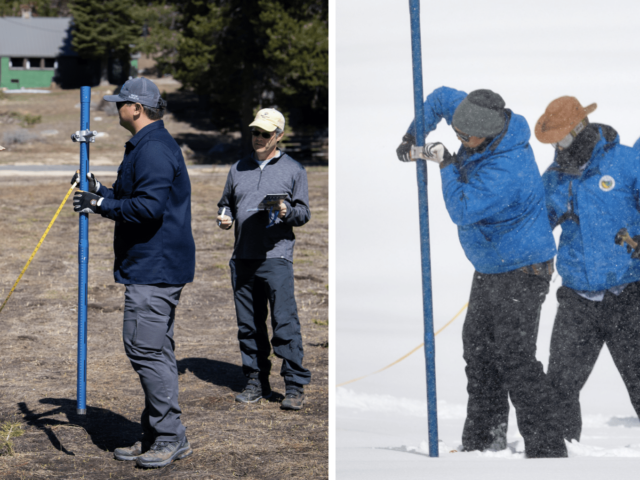California’s winter is officially one of the snowiest ever recorded, with the snowpack measured at 221% of normal on Monday by the California Department of Water Resources in its annual beginning of April survey.
California’s #snowpack is now one of the largest ever, bringing both drought relief and flooding concerns, however DWR’s State-Federal Flood Operations Center and DWR’s Snow Surveys and Water Supply Forecasting Unit are helping local agencies plan for the Spring snowmelt season. pic.twitter.com/RzSozSDEtM
— CA – DWR (@CA_DWR) April 3, 2023
The massive measurement is a sharp contrast to the measurement last year, when the snowpack was at just 2.5 inches, four percent of normal. Officials were surrounded by bare earth as they conducted the measurement.
This year, officials had to trek to the measurement site through heavy snow. The department announced:
“This year’s result will go down as one of the largest snowpack years on record in California,” said Sean de Guzman, manager of DWR’s Snow Surveys and Water Supply Forecasting Unit. “While 1952’s snow course measurements showed a similar result, there were fewer snow courses at that time, making it difficult to compare to today’s results. Because additional snow courses were added over the years, it is difficult to compare results accurately across the decades with precision, but this year’s snowpack is definitely one of the biggest the state has seen since the 1950s.”
For California’s snow course measurements, only 1952, 1969 and 1983 recorded statewide results above 200 percent of the April 1 average. While above average across the state this year, snowpack varies considerably by region. The Southern Sierra snowpack is currently 300 percent of its April 1 average and the Central Sierra is at 237 percent of its April 1 average. However, the critical Northern Sierra, where the state’s largest surface water reservoirs are located, is at 192 percent of its April 1 average.
The deep snowpack is welcome news to farmers and urban water users, who will receive 75% of the requested water allocation from the state — after an initial allocation of just 5%, based on predictions of a dry season.
However, the heavy snowpack also suggests that flooding is imminent with the spring snowmelt. Already, the historic freshwater Tulare Lake has reappeared after decades by flooding in the southern Central Valley.
Despite the unusually snowy and cold winter, officials blamed climate change, saying that California’s climate was becoming more extreme. However, evidence linking climate change and precipitation is inconclusive.
Joel B. Pollak is Senior Editor-at-Large at Breitbart News and the host of Breitbart News Sunday on Sirius XM Patriot on Sunday evenings from 7 p.m. to 10 p.m. ET (4 p.m. to 7 p.m. PT). He is the author of the new biography, Rhoda: ‘Comrade Kadalie, You Are Out of Order’. He is also the author of the recent e-book, Neither Free nor Fair: The 2020 U.S. Presidential Election. He is a winner of the 2018 Robert Novak Journalism Alumni Fellowship. Follow him on Twitter at @joelpollak.

COMMENTS
Please let us know if you're having issues with commenting.